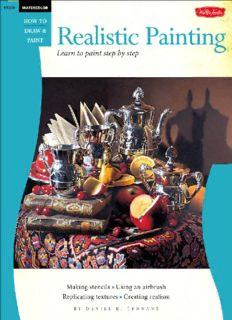
Watercolor: Realistic Painting PDF
Preview Watercolor: Realistic Painting
Realistic Painting There is a deep fascination with artwork that looks true to life. The aspiring painter often wonders how other artists are able to create works that are so persuasive. This book will show you step by step how these lifelike effects are achieved. Although other mediums can be used to achieve similar effects, I prefer gouache, or opaque watercolor. Gouache allows you to apply light colors over a darker underpainting—a method not possible with some mediums such as transparent watercolors. I also will show you how to work from photographs and use an airbrush to create amazingly detailed paintings. With practice, you will be able to build on your newly acquired skills and develop your own techniques for creating images with striking realism. —Daniel K. Tennant CONTENTS Materials and Tools Creating the Drawing Handling Darks and Lights Gouache The Airbrush Stenciling Airbrushing Basic Forms Painting Different Textures Shadows and Highlights Thoughts on Painting Planning a Painting Demonstration: August Afternoon Demonstration: Still Life with Lantern Demonstration: Still Life with Satin Pillow Demonstration: Last Light Demonstration: Still Life with Blue Cloth Demonstration: Heirlooms with Cherries MATERIALS AND TOOLS For optimum results , always buy the best materials and tools you can afford. Inferior materials will make the project more difficult, which can be discouraging, and higher-quality materials will last longer. GATHERING SUPPLIES Before painting, make sure you have all your basic supplies. Keep a bucket of water and a roll of paper towels on hand to rinse and dry your brushes between colors. GOUACHE Gouache is opaque watercolor (for more information, see page 6). For the best results, use high-quality, professional-grade paints, and select only those colors that are considered permanent. (Some pigments are fugitive, meaning that they fade when exposed to sunlight.) I recommend tubes over cakes because they are brighter, easier to mix large quantities of color, and have the best selection of colors. BUCKET OF WATER To ensure bright colors, use a bucket of water to rinse your brushes between colors. I recommend a gallon-sized bucket or can. PENCILS An HB pencil is good for preliminary drawings. HB lead is soft enough to leave a solid drawing, and gouache is not repelled when applied over it. ERASERS Standard rubber or kneaded erasers are good for cleaning up your drawings. The side of a kneaded eraser can be used for erasing large areas, and the eraser can be shaped to a point for erasing small areas. CHECKING YOUR COLOR PALETTE For the lessons in this book, you will need the colors listed below. alizarin crimson burnt sienna burnt umber cadmium red cadmium yellow cerulean blue Chinese orange cobalt blue Indian yellow watercolor ivory black ivory black watercolor Naples yellow permanent white sap green sap green watercolor ultramarine blue violet viridian green yellow ochre zinc white (Use zinc white for mixing. Permanent white may cause other colors to fade.) ILLUSTRATION BOARD A hot-pressed (smooth) surface is recommended over a textured surface. It allows you to create your own textures, and it also provides for the greatest amount of detail. The heavier the ply of the board, the better. (Four-ply is recommended.) Another option is museum board, which comes in an eight-ply weight. (Also see page 3.) BRUSHES I recommend only using red sable/synthetic hair watercolor brushes and a large flat watercolor brush for large areas. One of each standard size—00, 0, 1, 2, 4, and 6—should be sufficient. (I most often use a #2 brush.) A long-haired rigger brush is good for making thin lines. The large flat watercolor brush is excellent for laying in backgrounds quickly and smoothly and for covering large areas. BUYING BRUSHES Good brushes are expensive, but if you wash them thoroughly after each painting session, they should last a long while. Rinse the brushes in cool or lukewarm (never hot) water, and lather them lightly with mild soap. Rinse them again, and then shape the hairs so that they dry with a sharp point. SELECTING A PALETTE Whichever palette you choose should have enough wells to hold all your paint colors and a spacious flat area for mixing. Always place your colors in the same order on your palette to avoid wasting time searching for your desired color while painting.
Description: